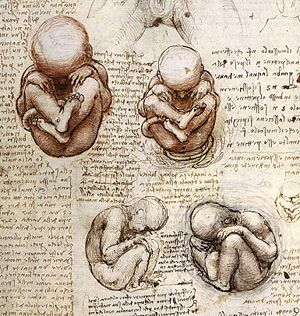Developmental biology

"Views of a Fetus in the Womb",
Leonardo da Vinci, ca. 1510-1512. The subject of prenatal development is a major subset of developmental biology.
Developmental biology is the study of the process by which organisms grow and develop. Modern developmental biology studies the genetic control of cell growth, differentiation and "morphogenesis," which is the process that gives rise to tissues, organs and anatomy. Developmental biology is that branch of life science,which deals with the study of the process by which organisms grow and develop.
Related fields of study
Embryology is a subfield, the study of organisms between the one-cell stage (generally, the zygote) and the end of the embryonic stage. Embryology was originally a more descriptive science until the 20th century. Embryology and developmental biology today deal with the various steps necessary for the correct and complete formation of the body of a living organism.
The related field of evolutionary developmental biology was formed largely in the 1990s and is a synthesis of findings from molecular developmental biology and evolutionary biology which considers the diversity of organismal form in an evolutionary context.
Perspectives
Developmental genetics is a very helpful process. It studies the effect that genes have in a phenotype. The findings of developmental biology can help to understand developmental malfunctions such as chromosomal aberrations, for example, Down syndrome. An understanding of the specialization of cells during embryogenesis may yield information on how to specialize stem cells to specific tissues and organs, which could lead to the specific cloning of organs for medical purposes. Another biologically important process that occurs during development is apoptosis - programmed cell death or "suicide". For this reason, many developmental models are used to elucidate the physiology and molecular basis of this cellular process. Similarly, a deeper understanding of developmental biology can foster greater progress in the treatment of congenital disorders and diseases, e.g. studying human sex determination can lead to treatment for disorders such as congenital adrenal hyperplasia.
Concepts in developmental biology
Developmental model organisms
Often used model organisms in developmental biology include the following:
- Vertebrates
- Invertebrates
- Plants (Plant embryogenesis)
Developmental systems biology
Computer simulation of multicellular development is a research methodology to understand the function of the very complex processes involved in the development of organisms. This includes simulation of cell signaling, multicell interactions and regulatory genomic networks in development of multicellular structures and processes (see French flag model or Biological Physics of the Developing Embryo for literature). Minimal genomes for minimal multicellular organisms may pave the way to understand such complex processes in vivo.
See also
- Evolutionary developmental biology
- altricial and precocial
- auxology
- fish development
- Important publications in developmental biology
- Plant Evolutionary Developmental Biology
Sources
|
Developmental biology |
|
| Embryology |
Embryogenesis - Human embryogenesis
|
|
| Other |
|
|
|
Developmental biology > Human embryogenesis (development of embryo) and development of fetus (some dates are approximate - see Carnegie stages and a timeline) |
|
| Week 1 |
Fertilization - Egg activation - Zygote - Cleavage - Morula - Blastula (Blastomere) - Blastocyst - Inner cell mass
|
|
| Week 2 |
Bilaminar disc (Hypoblast, Epiblast)
|
|
Week 3 (Trilaminar embryo,
germ layers) |
Archenteron/Primitive streak (Primitive pit, Primitive knot/Blastopore, Primitive groove) - Gastrula/Gastrulation - Regional specification
Ectoderm: Surface ectoderm - Neuroectoderm - Somatopleure - Neurulation - Neural crest
Endoderm: Splanchnopleure
Mesoderm: Chorda- - Paraxial (Somite/Somitomere/Sclerotome/Myotome/Dermatome) -
Intermediate - Lateral plate (Intraembryonic coelom, Splanchnopleure/Somatopleure) |
|
| Extraembryonic/uterus |
Trophoblast (Cytotrophoblast, Syncytiotrophoblast)
Blastocoele - Yolk sack/exocoelomic cavity - Heuser's membrane - Extraembryonic coelom - Vitelline duct
Umbilical cord (Umbilical artery, Umbilical vein, Wharton's jelly) - Allantois
Placenta - Decidua (Decidual cells) - Chorionic villi/Intervillous space - Gestational sac (Amnion/Amniotic sac/Amniotic cavity, Chorion) |
|
| Histogenesis |
|
|
| Organogenesis |
Limb development: Limb bud - Apical ectodermal ridge/AER
other structures: Eye development - Cutaneous structure development - Heart development - Development of the urinary and reproductive organs
|
|
|
Human development: biological - psychological - Overview table |
|
| Pre- and perinatal |
Prenatal development • Pre- and perinatal psychology
|
|
| Infancy |
Infant and child development (stages) • Infancy |
|
| Childhood |
Child development (stages)
Toddlerhood • Preadolescence
|
|
| Adolescence |
|
|
| Adulthood |
Early adulthood • Middle adulthood • Late adulthood • Ageing & Senescence |
|
| Theorists-theories |
|
|
